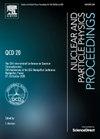Forward physics at LHC: Intersections with astrophysics
Q4 Physics and Astronomy
Nuclear and Particle Physics Proceedings
Pub Date : 2024-12-01
DOI:10.1016/j.nuclphysbps.2024.11.006
引用次数: 0
Abstract
LHC pp collisions at correspond to in the cosmic ray spectrum, reaching regions (f.i. the “knee”) whose interpretation is still debated, and whose models may be strongly influenced by LHC results on forward hadronic production, for instance as measured with CMS forward calorimeters. Other astrophysics problems that may receive a decisive input from LHC, and in particular HL-LHC, concern the interpretation of dark matter and dark energy in the universe, in correspondence with BSM (Beyond Standard Model) particles that may be detected as LLP (Long-Lived Particles). LLP searches have been generally done up to now at low pseudorapidity η, as exemplified by some CMS recent results. There may be however reasons why detectors in the forward direction of LHC experiments, could be better suited for these searches, at least for some lifetime ranges, due to large relativistic boosts of the produced particles at LHC energies in the forward region. Considering the CMS forward detectors, their role for some of these searches and corresponding signatures are discussed. Additional possibilities of instrumenting specific regions of the LHC tunnel near the interaction point IP5, where CMS is installed, are discussed.
大型强子对撞机的前沿物理学:与天体物理学的交叉
大型强子对撞机在s=14TeV的pp碰撞对应于宇宙射线谱中的1017eV,到达的区域(如“膝部”)的解释仍有争议,其模型可能受到大型强子对撞机的正向强子产生结果的强烈影响,例如用CMS正向量热计测量的结果。其他可能从大型强子对撞机(特别是HL-LHC)获得决定性输入的天体物理学问题,涉及宇宙中暗物质和暗能量的解释,与BSM(超越标准模型)粒子对应,这些粒子可能被检测为LLP(长寿命粒子)。到目前为止,LLP搜索通常是在低伪快速η下进行的,正如一些CMS最近的结果所证明的那样。然而,在LHC实验的前方方向上的探测器可能更适合于这些搜索,至少在某些寿命范围内,这可能是有原因的,因为在前方区域,LHC能量产生的粒子有很大的相对论性增强。考虑到CMS前向检测器,讨论了它们在其中一些搜索中的作用和相应的签名。讨论了在LHC隧道中安装CMS的交互点IP5附近对特定区域进行仪器测量的其他可能性。
本文章由计算机程序翻译,如有差异,请以英文原文为准。
求助全文
约1分钟内获得全文
求助全文
来源期刊

Nuclear and Particle Physics Proceedings
Physics and Astronomy-Nuclear and High Energy Physics
CiteScore
0.40
自引率
0.00%
发文量
0
期刊介绍:
Nuclear and Particle Physics Proceedings is the premier publication outlet for the proceedings of key conferences on nuclear and high-energy physics and related areas. The series covers both large international conferences and topical meetings. The newest discoveries and the latest developments, reported at carefully selected meetings, are published covering experimental as well as theoretical particle physics, nuclear and hadronic physics, cosmology, astrophysics and gravitation, field theory and statistical systems, and physical mathematics.
 求助内容:
求助内容: 应助结果提醒方式:
应助结果提醒方式:


